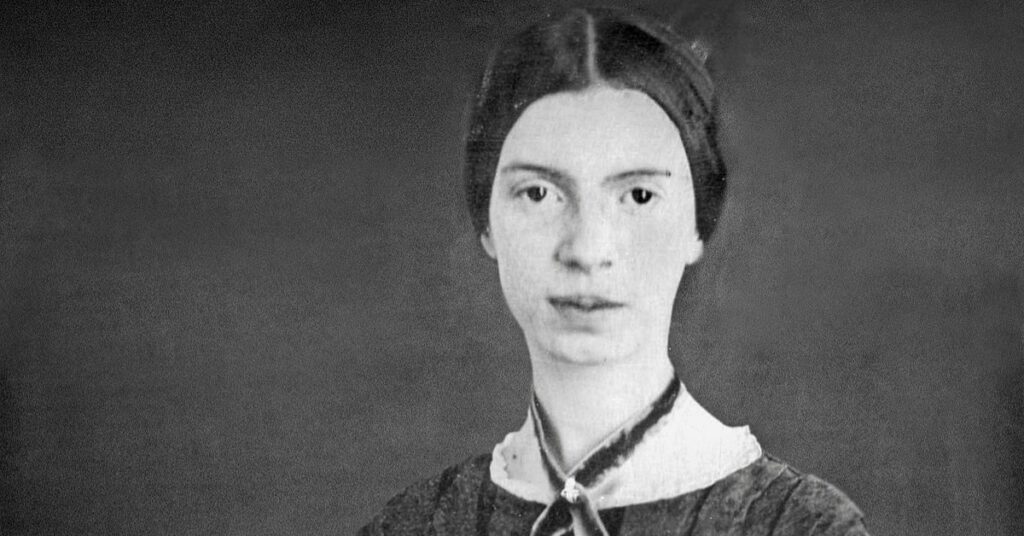Death of Beloveds
Death has an important place in Emily Dickinson’s poetry, and there’s a strong reason for it – she saw several people who she adored and loved die, some even very young. These tragedies played an important part in forming her thought and ideology, as her collection reflects. Dickinson portrays death in a romantic manner, infused with the emotion if grief and sorrow, having a lasting impression on her readers and researchers.
Following is a list of the people who died during the poetess’s lifetime, compelling her to adopt seclusion at a young age:
Sophia Holland (d.1844)
Sophia was Emily’s cousin sister and close friend, who died due to typhus in April 1844. This left Emily, who was just 14 at the time, traumatized to such an extent that her parents had to send her to live with their relatives in Boston.
Benjamin Franklin Newton (d.1853, not confirmed)
Benjamin Franklin Newton, a young attorney and a student of Emily’s father, had a tremendous influence on literary thinking. Newton was the one to introduce William Wordsworth, the legendary poet of the Romantic Age, to her. However, Newton passed away in 1853 due to tuberculosis, leaving Emily, now in her early twenties, devasted emotionally.
Leonard Humphrey (d.1850)
Leonard Humphrey was arguably the earliest influence on the literary mind of Emily Dickinson. He was the principal of Amherst Academy, where Emily studied and was the first to open the door of literature for her. The death of Humphrey was particularly devasting as he died suddenly due to brain congestion at the young age of 25. Emily was pushed into a touch of melancholy by the tragedy, and she could never recover completely, and it was as if a part of her being had departed.
Charles Wadsworth (d.1882)
Emily met Charles Wadsworth in 1855 on her visit to Philadelphia for a family visit. Wadsworth was a minister of the Arch Street Presbyterian Church, who passed away in 1882, four years before the poetess’s death. The extent of their friendship was such that Emily often referred to him as “my Philadelphia”, “my Clergyman”, “my dearest earthly friend”, and “my Shepherd from ‘Little Girlhood’”.
In this article, we discuss with reference to four poems of Emily Dickinson:
1. Because I could Not Stop for Death
2. I Heard a Fly Buzz – When I Died
3. A Bird Came Down the Walk
4. A Light Exists in Spring
As is apparent from the names of the first two poems, ‘death’ is an essential and integral element of Emily’s poems. Let’s analyze these four poems one by one.
Poem 1 – Because I could Not Stop for Death
In Because I could Not Stop for Death, Emily personifies Death as a gentleman caller, who took a leisurely ride with her, passing through her school, fields, and finally to her grave. She describes her grave as a house that looks swelling of the ground, which indicates that she romanticizes death, and is not fearful of it. She then speaks of immortality and eternity, which somewhat indicate that she believed in an afterlife. In the very last line, she says that she is running towards eternity, and will become immortal.
Poem 2 – I Heard a Fly Buzz – When I Died
In I Heard a Fly Buzz – When I Died, is one of her most famous and ambiguous poems. She talks about the moment of death from the perspective of a person who is already dead. On one hand, this death seems to be a typical one—the deceased is on her/his deathbed, surrounded by mourning beloveds, and their will is squared away. However, the irritating figure of the fly arrives and undermines the seriousness and gravity of the occasion. Though spoken from the great beyond, the poem offers no easy answers about death, instead of casting doubt on religious and social comforts.
Poem 3 – A Bird Came Down the Walk
In the third poem, A Bird Came Down the Walk, Emily discusses her thoughts about the beautiful and dark shades of nature. She describes the complexities of nature by portraying a bird that bites a worm into halves and eats it raw, and the same bird drinks the dewdrops on the grass and lets a beetle pass by. While there’s no direct reference to death in this poem, it symbolically represents the uncertainty of life.
Poem 4 – A Light Exists in Spring
The fourth poem, A Light Exists in Spring, is again a departure from the first two poems where death was an apparent element. However, like the third poem, this too has a complex portrayal of nature, expressing various human emotions. These emotions can also be attributed to the loss of a beloved. Nonetheless, death definitely takes a back step here, and Emily Dickinson becomes a poetess of nature and emotion rather than death. All that said, Emily Dickinson is definitely a poet of death and grief, and the four poems in the syllabus are not enough to justify the fact. She has written a plethora of poems depicting death, grief, sorrow, loss, and mourning. Some of these poems are, ‘I Like a Look of Agony’, ‘After Great Pain, a Formal Feeling Comes’, ‘One Need Not Be a Chamber – to Be Haunted’, and ‘It Was Not Death, For I Stood Up’.

Noman Shaikh is the co-founder and editor-in-chief of Bombay Reads. He grew up in Mumbai, a city he loves more than any other, and currently works as a content consultant. His expertise lies in creating high-quality academic and marketing content in the form of blogs, articles, op-eds, etc. Noman has worked with reputed brands, including Economic Times (through Spiral Media), Coinbase (through MattsenKumar), AdEngage, Della Group, GBIM Technologies, VAP Group, etc. For his published portfolio, click here. Contact Noman on noman@bombayreads for engagement.

